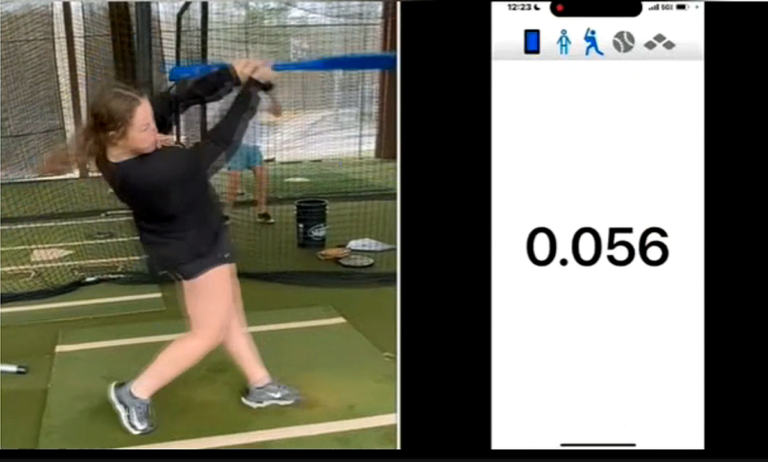
The Shadows Cast by the Launch Quickness (LQ) App’s Methodology on the HLP Swing Philosophy, Part II
By Ken Cherryhomes
Introduction
Video: The LQ App methodology explained and demonstrated
In this second part of a two-part series, we turn our focus to the methodology of the Launch Quickness (LQ) App, examining its role in the broader swing philosophy and the implications of its shortcomings.
What is Launch Quickness (LQ) and is it Different from Reaction Time?
Launch Quickness (LQ), a term coined by Richard Schenck (aka Teacherman), is central to his High Level Pattern (HLP) bat swing philosophy. It serves as a colloquial expression for adjusted reaction time, aiming to capture inefficiencies in a batter’s motion that extend the time required to initiate a bat swing. These inefficiencies—described by Schenck as “slop”—include hitches, leaks, and pauses that delay the “snap” movement critical to bat launch quickness.
Schenck describes LQ as “the ability to get your bat up to speed instantly” or “the time between your decision to swing and the actual launch of the swing.” The concept itself is sound and aligns closely with xFactor’s Swing Delay™. Both aim to measure adjusted reaction time, accounting for inefficiencies that extend response time beyond baseline reaction times. However, Schenck’s capture methodology lacks the structured approach necessary for accurate measurement, leaving LQ as a theoretical concept rather than a precisely measured or actionable metric.
LQ is essentially a branded interpretation of adjusted reaction time, a concept identical to Swing Delay™, first established by Ken Cherryhomes in 2001 as a component of the xFactor Hitting System algorithm. However, unlike Swing Delay™, the absence of an exacting capture methodology leaves the practical significance of LQ open to interpretation.
What is Swing Delay™, and How Does It Differ from LQ?
Richard Schenck’s aspirational concept of Launch Quickness (LQ) aligns closely with xFactor’s Swing Delay™. Both aim to capture the critical window between a batter’s cognitive decision and the physical execution of the swing.
Swing Delay™ captures the exact elements described by LQ—reaction time, inefficiencies, and delays—making the two metrics conceptually identical. However, they differ in methodology. Swing Delay™ employs a precise, proprietary framework that not only measures reaction time but also incorporates swing time as both a separate metric and part of Time to Impact (TTI). This allows Swing Delay™ to provide a comprehensive view of a batter’s swing time and execution, identifying inefficiencies beyond just launch quickness.
While any swing philosophy could produce a quick Swing Delay™ or LQ value, these metrics alone cannot determine overall time to contact or provide insights into barrel velocity. Schenck’s emphasis on “rearward launch” or “snap” conflates quickness with bat speed, failing to acknowledge that starting a swing quickly does not guarantee effective contact or power.
These shortcomings become even more apparent in the LQ App’s actual capture methodology.

The Flawed Methodology of the LQ App
The LQ App measures what Schenck refers to as the “snap” of the bat—the initial movement following a batter’s decision to swing. However, its scope is limited to detecting only the motion threshold breach, as captured by a mobile phone camera. The reported values, such as 0.056 seconds, or any value under 0.16 seconds, expose fundamental flaws in its methodology.
Human visuomotor delay alone—the time required for the brain to process a visual stimulus and send a signal to the muscles—ranges between 80 and 100 milliseconds (0.08 to 0.1 seconds). When motor response delay is added, even in its fastest form, the absolute minimum for initiating any physical response is closer to 160 milliseconds, even with anticipation. Any system reporting values as low as 0.056 seconds fails to account for these basic physiological realities.
Additionally, the LQ App relies on visual data captured through a mobile phone camera, which introduces significant limitations in its measurement process. Mobile cameras record in discrete frames, typically at a frame rate of 30-60 frames per second (fps). At 60 fps, each frame represents 16.7 milliseconds, while at 30 fps, each frame spans 33.3 milliseconds. This discrete sampling inherently introduces a margin of error, especially when attempting to capture micro-movements like the bat “snap” motion of a swing. Furthermore, the detection of such thresholds is inherently subjective unless paired with a reliable external reference signal, further complicating the app’s accuracy. Even at a mobile phone’s highest available frame rate—typically around 240 fps for slow-motion capture—each frame still represents approximately 4.17 milliseconds. While this is a significant improvement over 30 or 60 fps, the margin of error remains problematic when attempting to capture precise, instantaneous events like the “snap” of a swing.
Implications of Unrealistic Metrics
The app’s reported values are not only improbable but biologically impossible. These inaccuracies call into question the developer’s grasp of biomechanics and undermine the app’s credibility as a diagnostic tool.
For players relying on this app, the consequences are troubling. The pursuit of metrics that are physiologically unattainable can mislead players and coaches, diverting their focus from actionable improvements to chasing arbitrary and invalid benchmarks.
Beyond usability concerns, the promotion and sale of an app reporting such flawed metrics raise ethical issues. Whether these inaccuracies stem from ignorance or indifference, they reflect a fundamental failure in both measurement and methodology.
The Science Behind the Argument
The impossibility of the LQ App’s reported values becomes evident when examining reaction time components:
- Visuomotor Delay: The time required for the brain to process visual information and initiate a response, typically 80-100 milliseconds.
- Motor Delay: The time needed for neural signals to reach and activate muscles, typically adding another 150-200 milliseconds.
- Adjusted Reaction Time: Additional inefficiencies such as hitches or leaks further extend response time.
Together, these components place human reaction time within 200-250 milliseconds, with even elite athletes rarely reacting in less than 160 milliseconds. The LQ App’s reported values, such as 0.056 seconds, contradict these established limits.
Video: Unwitting customers chasing and believing impossible numbers
Conclusion
While both LQ and Swing Delay™ measure adjusted reaction time, Swing Delay™ uses a precise, scientifically validated process, ensuring accuracy and reliability. By integrating Swing Time as both a standalone metric and part of Time to Impact (TTI), Swing Delay™ delivers a complete picture of a batter’s swing time and efficiency.
The LQ App, in contrast, captures only the initiation of the swing using an unreliable methodology, producing values that are biologically impossible. Its flawed approach misleads users rather than providing actionable insights.
Ultimately, xFactor’s methodology sets the standard. By leveraging scientifically validated processes and integrating multiple metrics, Swing Delay™ transforms a theoretical concept into a practical tool that genuinely improves swing efficiency.
